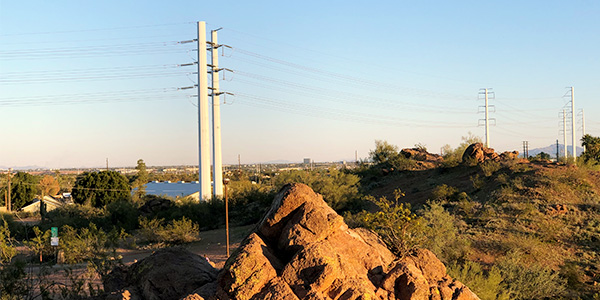By Hudson Sangree
TEMPE, Ariz. — Developers of transmission projects that would send wind power from rural Wyoming and New Mexico to cities in California and Arizona made their cases at this year’s Western Planning Regions Annual Interregional Coordination Meeting on Feb. 27.
The venue for this year’s forum was the Salt River Project’s sleek new LEED-certified meeting-and-classroom facility at its PERA Club, an employee recreation area. The building remains under construction, backed by the red rock formations and popular hiking trails of Phoenix’s Papago Park. High-voltage lines cross the area, juxtaposing transmission towers with distinctly Western scenery.
In a similar way, three transmission projects presented at the meeting would string nearly 1,500 miles of transmission lines, total, across the deserts and mountains of Arizona, Nevada, New Mexico and Utah if developers realize their plans.
The proposed projects include the long-sought Sunzia Southwest Transmission Project, which would link Pattern Development’s Corona Wind Projects, potentially one of the largest wind farms in the Western Hemisphere, to load centers in the Desert Southwest and Southern California via the Palo Verde Hub west of Phoenix.
The $2 billion project would consist of two bidirectional 500-kV lines with a total rating of 3,000 MW. A consortium of developers and utilities are behind the project including Southwestern Power Group, Shell WindEnergy and Tucson Electric Power.
Another project talked up at the meeting was TransCanyon’s Cross-Tie Project, which would traverse 213 miles through central Utah and Eastern Nevada at a projected cost of $667 million. TransCanyon is a joint venture between Berkshire Hathaway Energy and Pinnacle West Capital, the parent company of Arizona Public Service.
The third project presented at this year’s planning session was the TransWest Express, a $3 billion effort by The Anschutz Corp. to connect the company’s massive wind farms in eastern and central Wyoming with Southern California’s 24 million residents. It would run 730 miles, crossing Colorado and Utah, to the Marketplace Hub near Las Vegas.
Cost allocation remains a big question. The projects are merchant-driven and haven’t been fully embraced by Wyoming Wind Power Revs up, but is it too much?)
“There’s been very little planning activity on these because of the absence of regional need seen through these projects, but we’re hopeful that’s changing now as folks are seeing more penetration of renewables and the advantages of Wyoming wind,” said Dave Smith, director of engineering and operations with TransWest.
Bob Smith, a transmission planning consultant with TransCanyon, pointed out that load-serving entities in California, including two of the state’s large community choice aggregators, have signed power purchase agreements to buy Corona wind power, even though the SunZia lines to get it to the state don’t exist yet.
Powerful winds in central New Mexico blow before California’s solar arrays ramp up in the morning and after they go offline at night, potentially mitigating California’s reliability concerns going forward, according to a presentation delivered at a recent WestConnect stakeholder meeting, also at the PERA Club. (See CAISO, CPUC Warn of ‘Reliability Emergency’.)
Developers are hoping construction will start in 2021 or 2022 and that the first line will be in operation by 2024 or 2025.
No Interregional Needs
The planning meeting brought together stakeholders and representatives of CAISO, ColumbiaGrid, Northern Tier Transmission Group and WestConnect to discuss interregional coordination under CAISO Seeks More Transfers with Pacific Northwest.)
Each of the West’s four planning regions detailed its own transmission planning process, identifying regional needs based on reliability, economics and public policy per Order 1000’s requirements. But no interregional needs were identified in the current planning cycle that could streamline transmission in the Western Interconnection.
The impending merger of two of the four planning regions, ColumbiaGrid and Northern Tier, could give rise to new needs, planners said. FERC ruled on Dec. 27 that the proposed merger fell short of Order 1000’s goals of promoting competition and cost savings. It gave the filing entities — seven member utilities of ColumbiaGrid and Northern Tier — time to correct their application’s deficiencies. (See FERC: NorthernGrid Merger Needs More Work.)
NorthernGrid’s members would include Bonneville Power Administration, PacifiCorp, and publicly and investor-owned utilities in California, Idaho, Montana, Oregon, Utah, Washington and Wyoming. Dave Angell, vice president of regional transmission for Northwest Power Pool, one would-be member of NorthernGrid, said at the interregional coordination meeting that the utilities are planning to refile their plan with FERC soon.






